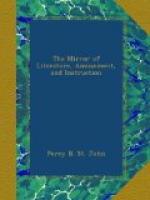Electricity.
Why is an arrangement of several Leyden jars called an electrical battery?
Because by a communication existing between all their interior coatings, their exterior being also united, they may be charged and discharged as one jar.
The discharge of the battery is attended by a considerable report, and if it be passed through small animals, it instantly kills them; if through fine metallic wires, they are ignited, melted, and burned; and gunpowder, cotton sprinkled with powdered resin, and a variety of other combustibles, may be inflamed by the same means.
Why is the fireside an unsafe place in a thunder-storm?
Because the carbonaceous matter, or soot, with which the chimney is lined, acts as a conductor for the lightning.
Why is the middle of an apartment the safest place during a thunder-storm?
Because, should a flash of lightning strike a building, or enter at any of the windows, it will take its direction along the walls, without injuring the centre of the room.
Combustion.
Why does amadou, or German tinder, readily inflame from flint and steel, or from the sudden condensation of air?
Because it consists of a vegetable substance found on old trees, boiled in water to extract its soluble parts, then dried and beat with a mallet, to loosen its texture; and lastly, impregnated with a solution of nitre.—–Ure.
Why is a piece of paper lighted, by holding it in the air which rushes out of a common lamp-glass?
Because of the high temperature of the current of air above the flame, the condensation of which is by the chimney of the glass.
We do not quote these specimens in the precise order in which they occur in the work, or to show the consecutive or connected interest of the several articles. In many cases we select them for their brevity and point of illustration.
[6] Consolations in Travel; or, the Last Days of a Philosopher. 1830.
* * * * *
THE GATHERER.
A snapper up of unconsidered trifles.
SHAKSPEARE.
* * * * *
SHIP-BUILDING.
To give an idea of the enormous quantity of timber necessary to construct a ship of war, we may observe that 2,000 tons, or 3,000 loads, are computed to be required for a seventy-four. Now, reckoning fifty oaks to the acre, of 100 years’ standing, and the quantity in each tree to be a load and a half, it would require forty acres of oak forest to build one seventy-four; and the quantity increases in a great ratio, for the largest class of line of battle ships. The average duration of these vast machines, when employed, is computed to be fourteen years. It is supposed, that all the full grown oaks now in Scotland would not build two ships of the line.




